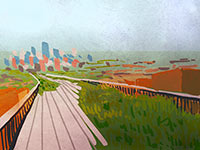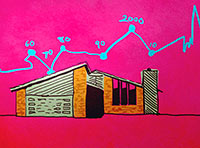COMMENT OF THE DAY RUNNER-UP: NAKED PEOPLE, SECURITY CAMERAS, AND YOUR COMMERCIAL LEASE AGREEMENT  “It’s a bad idea having naked people in common areas unless it is clearly stated in everybody’s leases that there exists the possibility of naked people turning up in the common areas and presuming that the common areas are not open to the general public. Among other things, the people that wandered into common areas naked after business hours may also not have assumed that there may be security cameras around. From every angle, what happened here was a lawsuit waiting to happen. (I say this as a guy that has owned a multi-tenant commercial property with a clause in the lease that would’ve addressed this situation, and permitted it. Yes, that stuff happens. It’s usually not very interesting; meaning I was never invited to attend.)” [TheNiche, commenting on League of Extraordinary Brewers, World’s First Brewery Incubator Brought Down by Wayward Game of Naked Twister] Illustration: Lulu
“It’s a bad idea having naked people in common areas unless it is clearly stated in everybody’s leases that there exists the possibility of naked people turning up in the common areas and presuming that the common areas are not open to the general public. Among other things, the people that wandered into common areas naked after business hours may also not have assumed that there may be security cameras around. From every angle, what happened here was a lawsuit waiting to happen. (I say this as a guy that has owned a multi-tenant commercial property with a clause in the lease that would’ve addressed this situation, and permitted it. Yes, that stuff happens. It’s usually not very interesting; meaning I was never invited to attend.)” [TheNiche, commenting on League of Extraordinary Brewers, World’s First Brewery Incubator Brought Down by Wayward Game of Naked Twister] Illustration: Lulu
Search Results: lulu
COMMENT OF THE DAY: NAVIGATING HOUSTON’S HEAVILY CONGESTED FUTURE  “I’m for better transit (I won’t be mode-specific here), but it should never be sold as making the streets less congested for you to drive around on. While it may take some cars off the streets, Houston’s congestion is likely to be massive enough that you’d never notice. Do NYC and LA have uncongested streets? Obviously not, even though both cities have much much better transit than Houston — meaning they have better alternatives to being in congestion and having to find parking. Congestion and difficult parking are our future (I wager even with self-driving cars, if they’re all personally owned) — everyone needs to be at peace with that.” [Local Planner, commenting on Killing Any Chance of Later Rail Conversion on the New Post Oak Bus Lanes; The Bedbugs of Beverly Hill] Illustration: Lulu
“I’m for better transit (I won’t be mode-specific here), but it should never be sold as making the streets less congested for you to drive around on. While it may take some cars off the streets, Houston’s congestion is likely to be massive enough that you’d never notice. Do NYC and LA have uncongested streets? Obviously not, even though both cities have much much better transit than Houston — meaning they have better alternatives to being in congestion and having to find parking. Congestion and difficult parking are our future (I wager even with self-driving cars, if they’re all personally owned) — everyone needs to be at peace with that.” [Local Planner, commenting on Killing Any Chance of Later Rail Conversion on the New Post Oak Bus Lanes; The Bedbugs of Beverly Hill] Illustration: Lulu
COMMENT OF THE DAY: THAT MONTROSE LOOK  “If you really look at the building, it resembles a typical three story townhome, shrunk and widened to one level. Even the arched facade mimics the townhome in the background. And let’s face, the neighborhood behind it is rapidly becoming a majority townhome area if it isn’t already. So maybe it does resemble the neighborhood after all. . . .
If you seriously look at Montrose, it is just a polyglot of everything. A lot of it is butt ugly but the trees and grown out landscaping obscure it. My neighborhood and its adjacents are filled with homes, apartments, offices, etc. spanning 90 years of different styles and much of it is seemingly incompatible if viewed as a single entity. That is Montrose. It ain’t The Woodlands!” [JT, commenting on Raising Cane’s Is Almost Ready To Grab the Corner of Hazard and Westheimer with Its Chicken Fingers] Illustration: Lulu
“If you really look at the building, it resembles a typical three story townhome, shrunk and widened to one level. Even the arched facade mimics the townhome in the background. And let’s face, the neighborhood behind it is rapidly becoming a majority townhome area if it isn’t already. So maybe it does resemble the neighborhood after all. . . .
If you seriously look at Montrose, it is just a polyglot of everything. A lot of it is butt ugly but the trees and grown out landscaping obscure it. My neighborhood and its adjacents are filled with homes, apartments, offices, etc. spanning 90 years of different styles and much of it is seemingly incompatible if viewed as a single entity. That is Montrose. It ain’t The Woodlands!” [JT, commenting on Raising Cane’s Is Almost Ready To Grab the Corner of Hazard and Westheimer with Its Chicken Fingers] Illustration: Lulu
COMMENT OF THE DAY: RAILROADED  “Southern Pacific (not Union Pacific, as one writer claimed), demolished this station in 1959. Critics may blame Houstonians for failing to rally and save the building, but the fact is that the modern architectural preservation movement didn’t start until the early 1970s, and even my architecturally hip home town of Chicago let some classic beauties like Louis Sullivan’s Stock Exchange slip away before public sentiment for preservation began to build. The first downtown railroad-station preservation-restoration project did not take place until 1973, when the Southern Railway’s vacant Terminal Station in Chattanooga was transformed into a restaurant and hotel complex.
If anybody has any photos of the interior of the SP station in Houston I would like to examine them for a book I’m writing about what happened to each of the big downtown stations in North America. SP’s Houston Station was designed by Texas’s most celebrated architect, Wyatt C. Hedrick, who also designed the Shamrock Hotel, the T&P station in Fort Worth, and dozens of admired hotels, factories and commercial buildings. Photos of his T&P station are all over the Internet but SP demolished his Houston station before anyone had a chance to make any good photos.” [F.K. Plous, commenting on The Secret Train Station Hidden Downtown] Illustration: Lulu
“Southern Pacific (not Union Pacific, as one writer claimed), demolished this station in 1959. Critics may blame Houstonians for failing to rally and save the building, but the fact is that the modern architectural preservation movement didn’t start until the early 1970s, and even my architecturally hip home town of Chicago let some classic beauties like Louis Sullivan’s Stock Exchange slip away before public sentiment for preservation began to build. The first downtown railroad-station preservation-restoration project did not take place until 1973, when the Southern Railway’s vacant Terminal Station in Chattanooga was transformed into a restaurant and hotel complex.
If anybody has any photos of the interior of the SP station in Houston I would like to examine them for a book I’m writing about what happened to each of the big downtown stations in North America. SP’s Houston Station was designed by Texas’s most celebrated architect, Wyatt C. Hedrick, who also designed the Shamrock Hotel, the T&P station in Fort Worth, and dozens of admired hotels, factories and commercial buildings. Photos of his T&P station are all over the Internet but SP demolished his Houston station before anyone had a chance to make any good photos.” [F.K. Plous, commenting on The Secret Train Station Hidden Downtown] Illustration: Lulu
COMMENT OF THE DAY: THE GALLERIA’S BEST-KEPT SECRET  “It’s true; the secret to making a visit to the Galleria tolerable (even *gasp* enjoyable) is to have a secret parking spot that’s always available. Like many commenters here, I hated going there. But when I finally found my spot, I no longer dread going there even on weekends! (Forget about the holidays though . . . ain’t nobody got time for that).
And no, I’m not telling any of you where it is.” [crono_clone, commenting on A Longtime Houstonian’s Guide To Surviving the Recent Onslaught of New Developments and Residents] Illustration: Lulu
“It’s true; the secret to making a visit to the Galleria tolerable (even *gasp* enjoyable) is to have a secret parking spot that’s always available. Like many commenters here, I hated going there. But when I finally found my spot, I no longer dread going there even on weekends! (Forget about the holidays though . . . ain’t nobody got time for that).
And no, I’m not telling any of you where it is.” [crono_clone, commenting on A Longtime Houstonian’s Guide To Surviving the Recent Onslaught of New Developments and Residents] Illustration: Lulu
COMMENT OF THE DAY: A LINEAR PARK TO CONNECT THE MED CENTER TO RICE VILLAGE  “If the Rice Village wants to be a retail goldmine, it should look outside its borders. My suggestion would be a linear public park that would take the residential properties between University and Dryden between the Medical Center at Travis all the way west to Greenbriar.” [infinite_jim, commenting on Haven Is No More; The Allure of the Suburban Town Square] Illustration: Lulu
“If the Rice Village wants to be a retail goldmine, it should look outside its borders. My suggestion would be a linear public park that would take the residential properties between University and Dryden between the Medical Center at Travis all the way west to Greenbriar.” [infinite_jim, commenting on Haven Is No More; The Allure of the Suburban Town Square] Illustration: Lulu
COMMENT OF THE DAY: A BRIEF ANNOTATED HISTORY OF ALLEN PARKWAY VILLAGE’S DIRTY NEIGHBOR  “Wow, I never knew there was a waste incinerator right in the Fourth Ward. Here’s a handy timeline:
Post-Civil War: Freed slaves construct their own neighborhood in the Fourth Ward.
1917: Camp Logan Race Riots are sparked off when a Houston policeman beats a black soldier in the Fourth Ward.
1920s: Gillette incinerator is built (PDF) right in the Fourth Ward.
1944: San Felipe Courts (today’s Allen Parkway Village) were built next to the incinerator. They were originally intended as public housing for the city (following a New Deal movement for public housing in the 1930s) but ended up being handed over to the defense department to exclusively house white WW2 veterans (PDF). The other motivation was to ‘clean up the slums’ along Allen Parkway for passing commuters.
1964: San Felipe Courts are desegregated following the Civil Rights Act and renamed to Allen Parkway Village.
1970s-90s: Developers advocated for APV’s demolition arguing that the public housing’s costs didn’t reflect the land’s ‘highest and best use.’ Meanwhile, the housing deteriorated due to neglect by the Houston Housing Authority and HUD. Residents organized and protested demolition leading to APV’s rebuilding in 1997.
Today: The city can now cash in by selling a plot of polluted land next to APV now that the Fourth Ward is gentrifying.” [Carpetbagger, commenting on The Best the City Can Get for Gillette; Not Jus Donuts’ Extreme Cakeover] Illustration: Lulu
“Wow, I never knew there was a waste incinerator right in the Fourth Ward. Here’s a handy timeline:
Post-Civil War: Freed slaves construct their own neighborhood in the Fourth Ward.
1917: Camp Logan Race Riots are sparked off when a Houston policeman beats a black soldier in the Fourth Ward.
1920s: Gillette incinerator is built (PDF) right in the Fourth Ward.
1944: San Felipe Courts (today’s Allen Parkway Village) were built next to the incinerator. They were originally intended as public housing for the city (following a New Deal movement for public housing in the 1930s) but ended up being handed over to the defense department to exclusively house white WW2 veterans (PDF). The other motivation was to ‘clean up the slums’ along Allen Parkway for passing commuters.
1964: San Felipe Courts are desegregated following the Civil Rights Act and renamed to Allen Parkway Village.
1970s-90s: Developers advocated for APV’s demolition arguing that the public housing’s costs didn’t reflect the land’s ‘highest and best use.’ Meanwhile, the housing deteriorated due to neglect by the Houston Housing Authority and HUD. Residents organized and protested demolition leading to APV’s rebuilding in 1997.
Today: The city can now cash in by selling a plot of polluted land next to APV now that the Fourth Ward is gentrifying.” [Carpetbagger, commenting on The Best the City Can Get for Gillette; Not Jus Donuts’ Extreme Cakeover] Illustration: Lulu
COMMENT OF THE DAY: A GUIDE TO SOUNDING OUT THE NAMES OF HOUSTON’S ACRONYMED SPORTS STADIUMS  “Just make up a pronunciation. “TDECU†becomes “tuh-DECK-you,†and is the response to “why Grandma, what big fists you have!â€
Likewise, “NRG†becomes “nurg†(a kind of parasitic technician) and “BBVA†becomes “bubba-VUH†(Popul Vuh’s brother from the country).” [Memebag, commenting on Here’s That Downtown View the University of Houston Rotated Its Football Stadium For] Illustration: Lulu
“Just make up a pronunciation. “TDECU†becomes “tuh-DECK-you,†and is the response to “why Grandma, what big fists you have!â€
Likewise, “NRG†becomes “nurg†(a kind of parasitic technician) and “BBVA†becomes “bubba-VUH†(Popul Vuh’s brother from the country).” [Memebag, commenting on Here’s That Downtown View the University of Houston Rotated Its Football Stadium For] Illustration: Lulu
COMMENT OF THE DAY: SCREWING THE HAVES  “Message to the cool kids: If you are really cool, move to a cheaper part of town. The squares who are pricing you out of Montrose will be punished by living exclusively among squares, and the cheaper part of town will be cool. However, if you move and none of that happens then you probably weren’t that cool.” [Memebag, commenting on New Owners to Montrose Apartment Dwellers: Everybody Out by the End of August, We’re Tearing These Places Down] Illustration: Lulu
“Message to the cool kids: If you are really cool, move to a cheaper part of town. The squares who are pricing you out of Montrose will be punished by living exclusively among squares, and the cheaper part of town will be cool. However, if you move and none of that happens then you probably weren’t that cool.” [Memebag, commenting on New Owners to Montrose Apartment Dwellers: Everybody Out by the End of August, We’re Tearing These Places Down] Illustration: Lulu
COMMENT OF THE DAY: BANKING ON OTHER PEOPLE’S FEARS  “. . . Housing preferences can be a multifaceted thing. However, when you look at patterns of socioeconomic segregation within society, yeah I would say that the evidence is damning . . . to society. (I do not have any policy prescriptions. I think that good intentions are too often and too easily co-opted by the powers that be.)
At the very least, at the barest minimum, a significant enough portion of homeowners anticipate that the market moves on the premise of socioeconomic segregation that their anticipation of demand for segregation is itself what makes the market segregated. This is the polite premise underlying white flight, and it was as true in Riverside 50 years ago as it was 10 years ago in Spring and Missouri City and as it is today in various places I prefer not to call out by name in order not to be part of the problem.” [TheNiche, commenting on The End of the New Starter Home in Houston; A Marketing Campaign for Airline Dr.] Illustration: Lulu
“. . . Housing preferences can be a multifaceted thing. However, when you look at patterns of socioeconomic segregation within society, yeah I would say that the evidence is damning . . . to society. (I do not have any policy prescriptions. I think that good intentions are too often and too easily co-opted by the powers that be.)
At the very least, at the barest minimum, a significant enough portion of homeowners anticipate that the market moves on the premise of socioeconomic segregation that their anticipation of demand for segregation is itself what makes the market segregated. This is the polite premise underlying white flight, and it was as true in Riverside 50 years ago as it was 10 years ago in Spring and Missouri City and as it is today in various places I prefer not to call out by name in order not to be part of the problem.” [TheNiche, commenting on The End of the New Starter Home in Houston; A Marketing Campaign for Airline Dr.] Illustration: Lulu
COMMENT OF THE DAY: A BY-THE-DECADE GUIDE TO HOUSTON HOME CLICHES  “. . . How to estimate when a home was built:
Before 1920s: has a historical marker out front.
1920 & 30s: large porched front on narrow lots.
1940s: houses built low to the ground — almost always look identical to each other.
1950s: seafoam green/Pepto Bismol-pink tile in the bathrooms.
1960s: wood paneling in the den.
1970s: diagonal exterior wood plank paneling.
1980s: skylights, skylights, skylights.
1990s: McMansion.
2000s: faux Tuscan exteriors.
2010s: Tear down something from the above list and build whatever in its place. Doesn’t matter what — we’ve run out of ideas at this point.” [Native Houstonian, commenting on Houston Home Listing Photo of the Day: Dead Animal Planet] Illustration: Lulu
“. . . How to estimate when a home was built:
Before 1920s: has a historical marker out front.
1920 & 30s: large porched front on narrow lots.
1940s: houses built low to the ground — almost always look identical to each other.
1950s: seafoam green/Pepto Bismol-pink tile in the bathrooms.
1960s: wood paneling in the den.
1970s: diagonal exterior wood plank paneling.
1980s: skylights, skylights, skylights.
1990s: McMansion.
2000s: faux Tuscan exteriors.
2010s: Tear down something from the above list and build whatever in its place. Doesn’t matter what — we’ve run out of ideas at this point.” [Native Houstonian, commenting on Houston Home Listing Photo of the Day: Dead Animal Planet] Illustration: Lulu
COMMENT OF THE DAY: WHAT COUNTS AS A SPRING IN HOUSTON  “The definition of a ‘spring’ can vary a lot, and is used loosely here.
In Harris County, where the topography is relatively flat, most of our ‘ponds’ and ‘lakes’ are either borrow pits (excavated to raise the grade elsewhere) or dammed-up gullies/ravines along existing bayous. In this case, it is the latter — a gully of Buffalo Bayou that was dammed up, then developed into a neighborhood.
A ‘spring’ is generally a point where the top groundwater table meets the surface. In our area, when we receive a lot of rain, the groundwater table can actually reach the surface. So a spring can range from a trickle of water to a puddle standing on the surface. When I dug the post holes in my backyard for my cedar fence, I hit groundwater at 2 feet deep because of recent heavy rain. In dryer periods, the water table drops, and springs continue to occur along steep cuts in the topography (either along a bayou that has eroded downward, or a man-made excavation). This is not what you find in the Hill Country, where large gaping holes in limestone spew thousands of gallons per hour, sometimes creating rivers out of nothing.
So effectively, any hole in Houston greater than 2 feet deep at some point will become ‘spring-fed.’ During the bad drought of the past few years, most likely the groundwater table dropped and stopped feeding this former gully of the bayou, and the ‘lake’ was most likely topped off by (1) automatic sprinkler runoff and (2) the small amount of storm water runoff they received, as the lake also serves as the neighborhood drainage ditch.” [Superdave, commenting on There’s a Tour of Texas and More in a Developer’s Lakefront Sandalwood Spread] Illustration: Lulu
“The definition of a ‘spring’ can vary a lot, and is used loosely here.
In Harris County, where the topography is relatively flat, most of our ‘ponds’ and ‘lakes’ are either borrow pits (excavated to raise the grade elsewhere) or dammed-up gullies/ravines along existing bayous. In this case, it is the latter — a gully of Buffalo Bayou that was dammed up, then developed into a neighborhood.
A ‘spring’ is generally a point where the top groundwater table meets the surface. In our area, when we receive a lot of rain, the groundwater table can actually reach the surface. So a spring can range from a trickle of water to a puddle standing on the surface. When I dug the post holes in my backyard for my cedar fence, I hit groundwater at 2 feet deep because of recent heavy rain. In dryer periods, the water table drops, and springs continue to occur along steep cuts in the topography (either along a bayou that has eroded downward, or a man-made excavation). This is not what you find in the Hill Country, where large gaping holes in limestone spew thousands of gallons per hour, sometimes creating rivers out of nothing.
So effectively, any hole in Houston greater than 2 feet deep at some point will become ‘spring-fed.’ During the bad drought of the past few years, most likely the groundwater table dropped and stopped feeding this former gully of the bayou, and the ‘lake’ was most likely topped off by (1) automatic sprinkler runoff and (2) the small amount of storm water runoff they received, as the lake also serves as the neighborhood drainage ditch.” [Superdave, commenting on There’s a Tour of Texas and More in a Developer’s Lakefront Sandalwood Spread] Illustration: Lulu
COMMENT OF THE DAY: CALL IT MIXED PARKING  “The true benefit of mixed-use developments is the opportunity to reduce the amount of parking provided. Certain program types work well with others. For example, an office worker is usually parked in their space between 8 and 5 while other uses, such as residential and retail, pick up before and after those hours. This means the same space can potentially serve multiple uses, reducing the amount of garages and lots. This is a big deal in Houston, where market parking demands for office require about the same square footage of parking as the office space itself.
Mixed-use development can be about convenience, but the true potential lies in the opportunity to reduce the amount of useless parking and increase density and thus walkability. Houston actually has a mixed-use parking code that allows for this reduction. Ultimately, one could argue that mixed-use developments are not just good for reducing costs for developers, but they are also good for the planet.” [Mixitup, commenting on Comment of the Day: Stuck With That Same Ol’ Mix of Uses] Illustration: Lulu
“The true benefit of mixed-use developments is the opportunity to reduce the amount of parking provided. Certain program types work well with others. For example, an office worker is usually parked in their space between 8 and 5 while other uses, such as residential and retail, pick up before and after those hours. This means the same space can potentially serve multiple uses, reducing the amount of garages and lots. This is a big deal in Houston, where market parking demands for office require about the same square footage of parking as the office space itself.
Mixed-use development can be about convenience, but the true potential lies in the opportunity to reduce the amount of useless parking and increase density and thus walkability. Houston actually has a mixed-use parking code that allows for this reduction. Ultimately, one could argue that mixed-use developments are not just good for reducing costs for developers, but they are also good for the planet.” [Mixitup, commenting on Comment of the Day: Stuck With That Same Ol’ Mix of Uses] Illustration: Lulu
COMMENT OF THE DAY: STUCK WITH THAT SAME OL’ MIX OF USES  “I don’t get people’s desire to live in a Mixed Use development, I lived in one for a couple of years and it’s as useless as a sh*t flavored lollipop. You get tired of the couple of restaurants there within 2 weeks, the drycleaner is not as good as the one you’re used to and you end up driving there anyway, you get all the noise and the traffic to deal with without any real world benefit. It’s the true case of the ‘grass is greener on the other side.'” [commonsense, commenting on Studemont Grocers Supply Redevelopment To Feature Fast Food and Bank Drive-Thrus, Store Pods in Parking Lot Now, Apartments Later] Illustration: Lulu
“I don’t get people’s desire to live in a Mixed Use development, I lived in one for a couple of years and it’s as useless as a sh*t flavored lollipop. You get tired of the couple of restaurants there within 2 weeks, the drycleaner is not as good as the one you’re used to and you end up driving there anyway, you get all the noise and the traffic to deal with without any real world benefit. It’s the true case of the ‘grass is greener on the other side.'” [commonsense, commenting on Studemont Grocers Supply Redevelopment To Feature Fast Food and Bank Drive-Thrus, Store Pods in Parking Lot Now, Apartments Later] Illustration: Lulu
COMMENT OF THE DAY: WHO’S SUPPOSED TO FIX YOUR WONKY SIDEWALK  “When I was a Super Neighborhood President, I learned all about sidewalks. In general, they are the responsibility of the adjacent property owners — UNLESS they are adjacent to or on a heavily traveled route to a school. Then the City of Houston will build them as part of their Safe Sidewalk Program (SSP). They also have a deal where if PWE digs up a sidewalk or driveway curb cut for any reason, they will replace it — like juancarlos said. But that’s kind of a given. (If they didn’t, they’d be real douches).
That being the case, if Montrose residents are begging the City for better sidewalks, they’re probably barking up the wrong tree. I wonder if it would be better to get together with commercial and multifamily owners in the area, and lobby the Management District to do it. The Montrose District has funding, unlike the Civic Clubs and Super Neighborhoods, and they also have the project management skill to get this sort of thing done. And if I’m a business or apartment owner who pays an assessment, I want something in return; a new sidewalk for my customers would be nice.” [ZAW, commenting on Replacing a Texas City H-E-B with an H-E-B; Would You Like Taller Billboards?] Illustration: Lulu
“When I was a Super Neighborhood President, I learned all about sidewalks. In general, they are the responsibility of the adjacent property owners — UNLESS they are adjacent to or on a heavily traveled route to a school. Then the City of Houston will build them as part of their Safe Sidewalk Program (SSP). They also have a deal where if PWE digs up a sidewalk or driveway curb cut for any reason, they will replace it — like juancarlos said. But that’s kind of a given. (If they didn’t, they’d be real douches).
That being the case, if Montrose residents are begging the City for better sidewalks, they’re probably barking up the wrong tree. I wonder if it would be better to get together with commercial and multifamily owners in the area, and lobby the Management District to do it. The Montrose District has funding, unlike the Civic Clubs and Super Neighborhoods, and they also have the project management skill to get this sort of thing done. And if I’m a business or apartment owner who pays an assessment, I want something in return; a new sidewalk for my customers would be nice.” [ZAW, commenting on Replacing a Texas City H-E-B with an H-E-B; Would You Like Taller Billboards?] Illustration: Lulu

